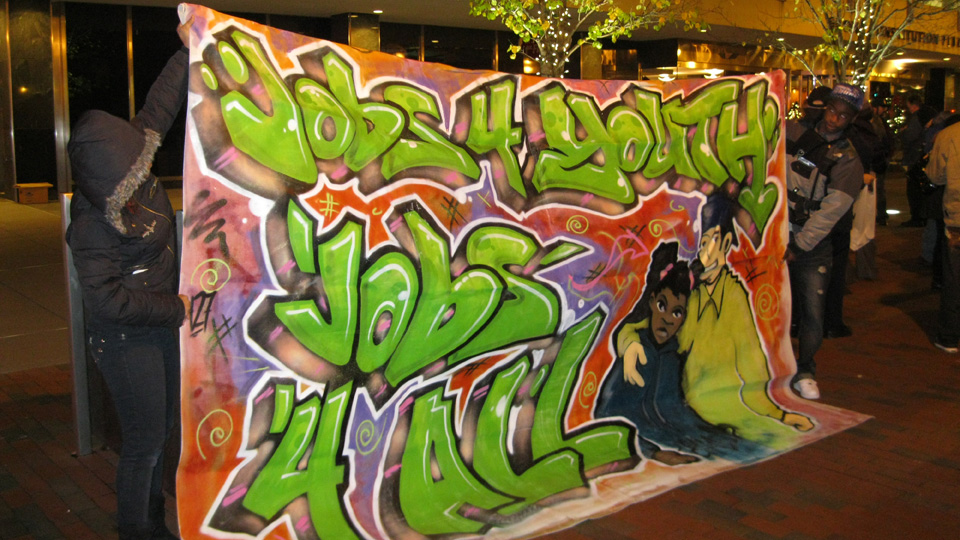
NEW HAVEN, Conn—One recent New Haven headline: “14-year-old boy killed by gunfire.” A second headline: “Youth employment program hit by state funding cuts.”
These are not separate stories. And they are not new.
Youth@Work, New Haven’s main source of summer jobs for high school students, scraped together funding for 670 teen jobs this summer. The jobs were with city departments and non-profits. The youth worked answering phones, planting trees, and picking up trash. They worked as counselors and supervisors for children’s camps and sports programs.
For years, Youth@Work has been seen as part of the solution to violent crime that tends to spike in the summer. In 2014, Mayor Toni Harp told a press conference, “If they really want to see the streets safe, they should be hiring our young people.”
The Newhallville community, where 14-year-old Tyrick Keyes was killed, understands the link. Residents are calling on elected officials to create jobs.
This is hardly a new thought. In 2011, against a background of gun violence that claimed 31 young lives, a group of youth came together and formed the New Elm City Dream. With the slogan, “Jobs for Youth, Jobs for All,” they held marches and vigils linking the levels of violence with the lack of jobs. They got involved in the city politics, helping to focus attention on the issues of jobs, youth services, and security.
The decision by a new Board of Alders and mayor to prioritize jobs, youth needs, and safe streets is having an impact. Along with the unions at Yale and the community affiliate New Haven Rising, the university has committed to to hiring 500 people from New Haven’s neighborhoods with high unemployment—a commitment which must be monitored.
2011 saw the worst of the economic crisis throughout the country as well as in New Haven, where blocks-long lines formed when a fast-food chain announced they were hiring. That summer nationally, only two in ten Black or Hispanic youth aged 16-19 were able to find a job. New Haven undoubtedly reflected that reality.
The situation has improved somewhat since then. Nationally, about three in ten Black or Hispanic youth held jobs this summer. But if there was real full employment, more than twice as many would have been working.
In New Haven this summer, there were slots for 670 of the 1,000 who applied for the Youth@Work program. Funding those jobs was a stretch for New Haven. Federal funding dried up decades ago. Due to Connecticut’s budget crisis, no funding was available from the state this year. Mayor Harp and youth services director Jason Bartlett rounded up corporate donations and tapped city funds, hoping to get reimbursed when a state budget is finally passed.
States, cities, and communities across the country face the same problems. Summer jobs for youth in the private sector have been dwindling, while state and local governments have been trying to do more with fewer resources.
In past years in New Haven, as many as 1,200 summer jobs were filled by Youth@Work. According to Bartlett, if funding were available, building on Youth@Work’s existing programs could raise placement as high as 1,500 in New Haven. “Finding work sites or jobs is not hard—most sites want more kids than available,” he told People’s World.
Even that might not be enough. Applications for Youth@Work must be turned in by April 1 each year. What happens to those who don’t look three months ahead? Based on population and national labor force data, an additional 2,000 jobs would be necessary to meet the potential demand in New Haven.
Summer jobs for youth is a nationwide issue, and it demands national action. Nationwide, six million teenagers had jobs this summer. An additional four million jobs would have been needed to equal the level of the late 1990s, and even then, many teens were unable to find work.
Ten billion dollars would pay for those 4 million summer jobs, including the 2,000 needed in New Haven. The military budget is set to increase next year by at least $60 billion. It’s not a matter of lack of money, but rather a matter of setting priorities.
Of course, summer jobs are only one part of the problems of violence and poverty in too many working-class communities. For youth who are no longer in school, full-time, year-round, steady jobs with a living wage and benefits are needed. And parents need good jobs, with predictable schedules, family medical benefits, and paid sick time.
For New Haven, an additional 2,000 summer jobs might cost between four and six million dollars. This would include additional hiring of outreach workers, supervisors, planning, and supplies. This might not be possible for an already overstretched city budget. But imagine the impact on our communities, our schools, and the lives saved if a normal and accepted part of life for all of our youth were access to a summer job, learning useful skills, working with others, contributing to the community, and earning much-needed income.
And imagine if those summer jobs for youth were part of a much larger national jobs program that could put millions of all ages to work rebuilding our infrastructure, preserving our environment, educating our kids, and meeting the countless needs of our communities.












Comments